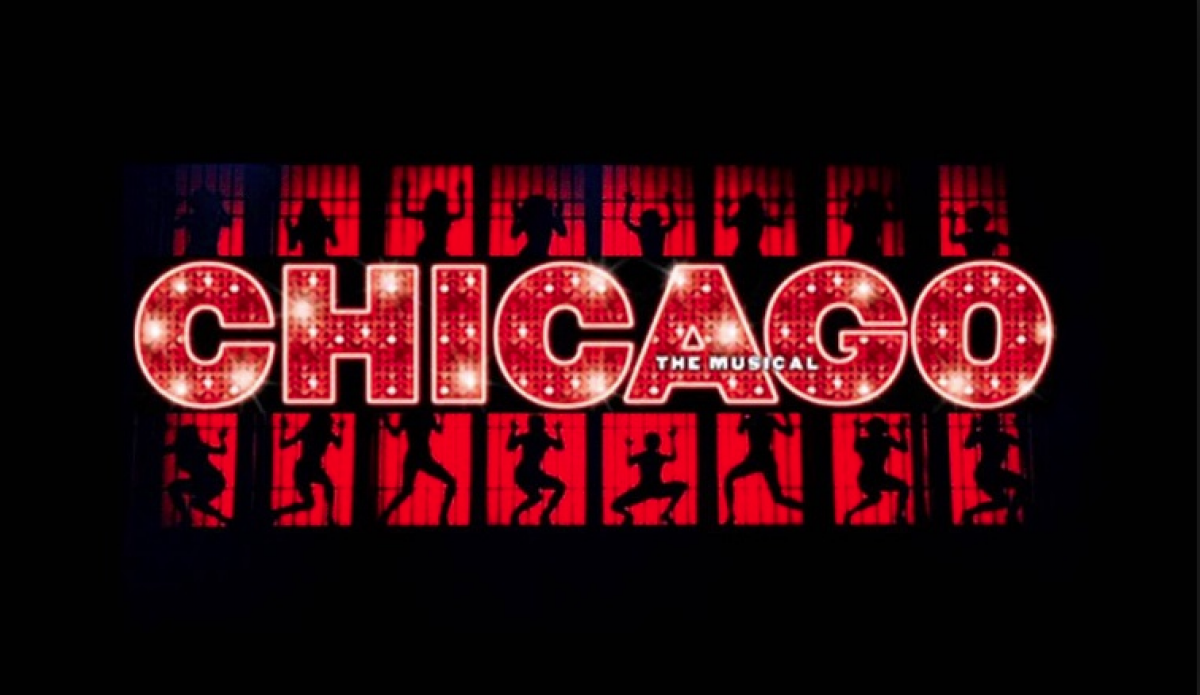Introduction
Our first task as an events team was to understand all of the potential problems we faced and the jobs that we had to undertake. We were split into 5 teams with two students in each. The job I was handed was contracts and budgets. We individually proposed ideas in terms an event strategy and potential venue, my idea was to fund raise for refugees in Bradford and Calais. I hoped to work with charities in Bradford and established event networks in order to increase the audience. My venue of choice was formally the M and S shop on Darley street in Bradford as I had often seen music events organised here and it gave a lot of potential to creating our own event in terms of stage set up and decorations. I had a productive conversation in order to hire the venue over email, which can be seen below. In the democratic process of the events team , my idea didn’t receive enough votes to become the focus of the project, therefore it’ll be something I look at do in the future.
Venue and Budget
In this project we were given a very restrictive budget which had to be managed very seriously in order to try and accomplish as much as possible.
The venue that was chosen in the end was called Black Dyke mill in Queensbury.
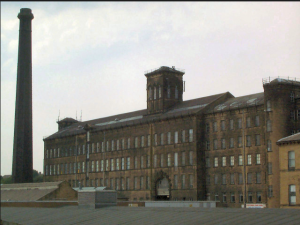
Spencer, D. (2018). Black Dyke Mills, Queensbury (C) David Spencer. [online] Geograph.org.uk. Available at: http://www.geograph.org.uk/photo/39557 [Accessed 15 Oct. 2018].
A key part of choosing this venue was that the level 3 year 1 students needed to set up the PA as part of their assessment as well as the venue staff being very reasonable on pricing.
Health and safety
Pat testing is a precautionary procedure that is used to test electronic devices. Although it is not a legal requirement to consistently test your equipment in this way, there are legal requirements put in place to make sure that all of your equipment is in good condition and is safe to use. Pat testing therefore is a great way to make sure that equipment is up to the legal standard.
Noise levels can be very dangerous in a live performance setting, according to the government health and safety website, volume levels should be kept under 107 decibels at all time. In order to decrease this risk, we did a sound check with every band prior to the performance allowing us to dictate the levels of sound as well as free ear plugs being available in case anyone needed any.
In terms of capacity we needed to work with promotions who were sorting out ticketing as the venue capacity was 120, therefore we needed to manage the amount of people coming in and foresee how was best to set up the venue to receive them.
Usually, a venue would supply both trained security and first aid staff. However for this event the venue asked us to supply both door staff and first aiders. Luckily I am first aid trained, therefore it wasn’t a big issue.
Insurance
The main area of insurance we needed for this project was public liability.
Public liability insurance is one of the main types of business. It can cover compensation payments and legal costs if a member of the public (maybe a customer, a supplier, or a passerby) sues your business because they’ve been injured or their property has been damaged.
Thankfully by putting on this event in the name of Bradford college, we were fully covered with public liability insurance, meaning that in the event of any incident to do with damages or injury we would be fully covered. However it was something that we needed to look into as if something goes wrong and there is no insurance to cover that incident, the organiser could be required to pay compensation.
Contracts
Approaching the task of writing a professional contract for the first time, I was confused as to what it should contain.
https://bizfluent.com/how-4842604-write-music-contract.html
After reading this article, I discovered that the idea of a contract was much simpler than comes across when you here about contract law. Although contracts can range massively in how simple or complicated they are, the purpose of a contract is generally the same. It is a signed agreement on paper between two parties and therefore acts as clear evidence if the terms and agreements are breached. As an event manager, you would often be expected to sign multiple contracts including one with the venue, any companies that you use for your event as well as potential performers at that event. For this project, we were expected to write a contract for the musicians to sign.
The article above gives a couple of examples of potential clauses that could be introduced into a contract to set some basic ground rules for both the event manager and the artists to deliver on.
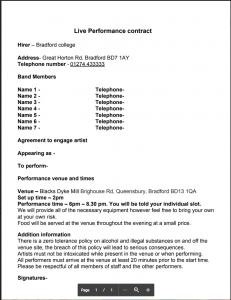
Here is the first draft of a contract that I did. It was mainly based on the contract seen below.
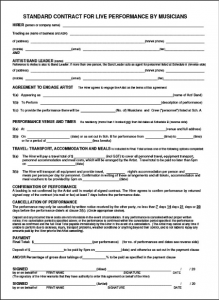
Sections that I changed from this template included payment as this concert was for charity, therefore no payment was involved. Another part was the additional information that I decided to include on the contract, this mostly focused on requested areas of punctuality and behaviour as requested from other groups working in this project. The zero tolerance in alcohol was especially important as the venue we were using for this project did not hold an alcohol license, therefore any breach in this clause would result in bad consequences on both sides.
Here is the completed contract that we used.
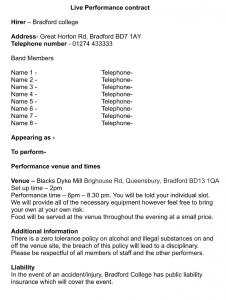
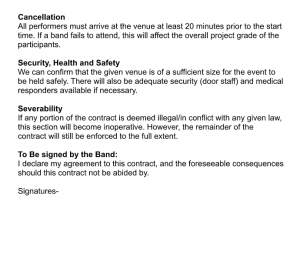
Here are 3 contrasting contracts that were signed.
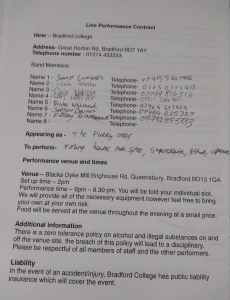

Firstly is our full band The Funky Ones, therefore 7 people have signed one contract.
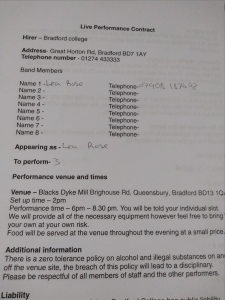
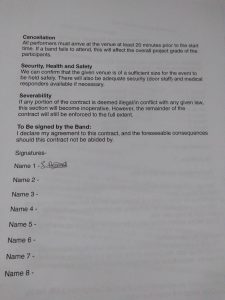
Secondly Is Leah’s , who was performing on her own.
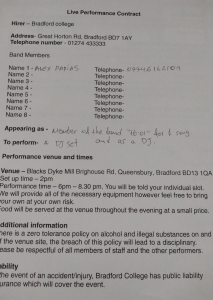
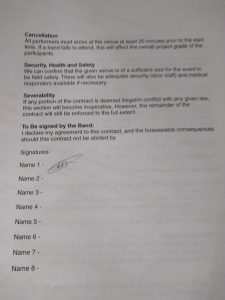
Finally this is Alex’s who was performing both as a DJ and as a member of a band for one song. The reason I have included these examples is to show you that a band and an individual artist received the same contract as well as to show an insight into how different people signed their contract.
Door and venue security
For this event myself and Leah Mellor took on the responsibility of being the door staff and security throughout the set up and performance of the concert. Some of the tasks we faced included managing students, assessing the venue and finally being on the door for the evening.
In preparation for the gig, a plan was drawn in order to give the day a certain structure and make our time management more efficient. The plan was made up of 4 sections. The first section was bringing the equipment from the van into the venue and setting it up in its relevant places. Our role in this as well as helping to move the equipment was to oversee the general process, give advice on health and safety procedures in addition to making sure everyone was present and participating in the process. We were essentially overviewing the process and doing our best to help people if they required any support besides keeping track of everyone.
The 2nd part of the schedule was to soundcheck every band, we were the final band to soundcheck therefore whilst waiting for our time slot, we were making final preparation’s for the evening. This included arranging the room in order to best suit the audience we were receiving. The original set up of the room wasn’t completely practical in terms of the set up off chairs and tables. Although this part sounds like a very menial part of the process, it was integral to creating a great atmosphere for the evening performance. A small touch I added was to work with the venue and to introduce candles around the room in order to create an intimate ambience.
Between each section of the schedule, there was an allocated 15 minute break. Me and Leah created a register which we used to keep track of where people were and it was our job to find out and chase up people if they didn’t turn up in time. Below is the register we used.

The 3rd part of the plan was the performance. Similarly to the soundcheck, we were the last band onto the stage. Therefore me and Leah were designated the job of door security. We were issued a ticket list which gave us an easy job of checking tickets as it gave us the name of the person who had ordered the ticket as well as the amount of tickets booked in their name. We were also in charge on the donation box and making sure that everyone had the information that they needed.
Finally we needed to pack down the equipment which was relatively easy to organise and no problems ensued.
